Maentwrog is a village which lies on the A496 in the Vale of Ffestiniog just below Blaenau Ffestiniog, in the ancient county of Merionethshire, within the Snowdonia National Park. The name Maentwrog means ‘Twrog’s stone’, and according to local folklore, a giant known as Twrog hurled a boulder from the top of a hill down into the settlement, destroying a pagan altar. The village Church is dedicated to St. Twrog. The village is ancient, though its population was greatly expanded in the 19th century as a result of all of the workers moving to the area to work in the local slate mines. Within the village is Plas Tan y Bwlch, former home of the Oakeley family, prominent owners of several slate mines in the area. The men of Maentwrog who fell during the Great War, as well as one man who was killed in the Boer War, are commemorated on the Maentwrog War Memorial, which is located in a garden of remembrance on Village Street, and takes the form of a Celtic Cross. The memorial was unveiled on 22 April 1922. There are no World War Two names on the memorial, but I have taken the liberty of adding the details of two people, one man and one woman, with links to Maentwrog who died during the latter war.
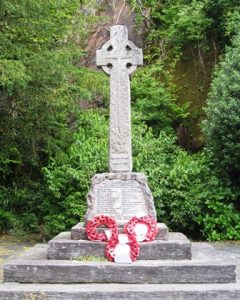
The Boer War, 1899-1902
Thomas Humphries Griffiths, Private, 5630, Welsh Regiment. Thomas was the son of Owen and Mary Griffiths, of Fronoleu, Maentwrog. He enlisted into the Welsh Regiment at Aberdare on 14 April 1898, and was posted to the 1st Battalion, Welsh Regiment. The battalion was sent out to South Africa following the outbreak of the Second Boer War, and sailed on the SS Kildonan Castle, arriving at the Cape about 22 November 1899. The 1st Welsh was employed in the central district of Cape Colony, before joining the 18th Brigade in the 6th Division. The battalion took part in its first action at Paardeberg on 20 February, attacking a Boer laager at bayonet point. On 6 March the 1st Welsh took part in another action at Poplars Grove, or Osfontein, and on 10 March 1900 took part in the Battle of Driefontein, where the battalion again assaulted the Boer positions at bayonet point under heavy rifle and machine-gun fire. Thomas was among 32 men killed and over 105 wounded during the battle that day. He was 19 years old.
The Great War, 1914-1918
Evan Davies, Lance Corporal, 19965, Royal Welsh Fusiliers. Evan was the son of John and Grace Davies, of Llwyneifion, Gellilydan, Blaenau Ffestiniog. He worked as a Colliery Engine Driver in South Wales prior to the war and lodged at 17, Islwyn Street, Cwmfelinfach. Evan enlisted at Newport, Mon into the Royal Welsh Fusiliers soon after the outbreak of war and was posted to the 9th Battalion, Royal Welsh Fusiliers. The battalion formed at Wrexham, before moving to Tidworth to join 58 Brigade, 19th (Western) Division. On 19 July 1915 Evan landed at Boulogne with the battalion, before the entire division moved to positions to the north of Loos, near Givenchy. The Division launched a diversionary assault near Givenchy on 25 September 1915, in an attempt to draw German attention away from the main offensive at Loos, but suffered terrible casualties from machine-gun fire, making no gains. The 9th RWF alone suffered 249 casualties, whilst the 9th Welsh suffered even more. The Division then enjoyed a brief rest before taking over trenches at Cambrin, and then moved to positions at Vielle Chapelle. The Division then moved back into the Festubert area over the winter, enduring terrible conditions in the water-logged trenches. The Division then helped train the newly arrived 38th (Welsh) Division over the winter. Evan was probably wounded on 31 December 1915, when the 9th RWF suffered a German artillery bombardment. He was evacuated to the Hospital at Merville, where he died of his wounds on 10 January 1916, aged 23. Evan is buried in Merville Communal Cemetery, France.
Richard Price Hughes, Private, 8849, Royal Welsh Fusiliers. Richard was the son of Owen and Mary Anne Hughes, of Maentwrog. He married Ellen Jones in 1913, and the couple set up home at 4, Minffordd Terrace, Gellilydan, where their two children were born. Richard enlisted at Wrexham into the Royal Welsh Fusiliers at some time prior to the war, and embarked for France with the 2nd Battalion, Royal Welsh Fusiliers on 13 August 1914. The battalion was initially placed on Lines of Communication at Rouen, before joining 19 Brigade at Valenciennes, taking part in the retreat to the Marne with the BEF. Following the Battles of the Marne and the Aisne, 19 Brigade moved to Flanders with the BEF, and eventually took over the La Boutillerie sector after becoming attached to the 6th Division. The Division then spent several months at Bois-Grenier, then on 31 May 1915, 19 Brigade transferred to the 27th Division. The Brigade was then temporarily attached to the 2nd Division on 19 August, taking part in the Battle of Loos, and subsequent Action of Hohenzollern Redoubt, before joining the newly arrived 33rd Division on 25 November 1915. The Division endured a hard time during its first few months in the line, holding such notorious sectors as Cambrin and Cuinchy, where underground warfare was prevalent. On 22 June 1916 the Germans exploded a massive mine beneath the position held by B Company, 2nd RWF, which killed 54 men of the battalion, as well as trapping a number of British tunnellers underground. During the attempted rescue of one tunneller, a soldier of the 14th Welsh, Sapper Hackett was awarded the VC. At the beginning of July the 33rd Division moved out of the sector and began to move into the Somme area. By 16 July the 2nd RWF were bivouacked in the newly captured Mametz Wood, and moved to Bazentin-le-Petit two days later, to take part in the assault on High Wood. The battalion suffered heavy casualties at High Wood, and moved back into reserve at Buire-sur-L’Ancre until 6 August and then spent several days at Becordel before moving back into the line at High Wood on 18 August, and helped beat off a German counter-attack. On 22 August 1916 the 2nd RWF moved into the support line at Bazentin-le-Grand, and six men were killed by artillery fire during their relief. Richard was among those killed. The 28-year-old has no known grave and is commemorated on the Thiepval Memorial, France.
Evan Jones, Private, 26112, Royal Welsh Fusiliers. Evan was the son of Hugh and Elizabeth Jones, of Tafarnhelyg, Tanyblwch. He worked as a farm servant prior to enlisting at Blaenau Ffestiniog into the 17th Battalion, Royal Welsh Fusiliers on 31 May 1915. The battalion was raised at Llandudno, joining the 43rd (Welsh) Division and trained in North Wales before moving to Winchester in the summer of 1915, where the battalion joined the re-numbered 115 Brigade, 38th (Welsh) Division. The Division moved to France on 2 December 1915 and moved to the Nursery Sector near Fleurbaix for trench initiation alongside the Guards Division. The Division then held a sector of the line near Cuinchy before marching south to the Somme sector in June 1916 to take part in the assault on Mametz Wood. The first attack on the wood was launched on a two-battalion front on 7 July, but failed, and the Divisional Commander, Sir Ivor Philipps, was replaced before the Division attacked again on a two Brigade front on 10 July 1916. After two days of ferocious hand-to-hand fighting, the wood was cleared up to its northern edge, before the battered Division was relieved. It then took over a section of the front at Hébuterne before moving to the Ypres Salient, and taking over the Canal Bank sector at Boesinghe. The infantry battalions of the Division then began carrying out the normal pattern of rotation in the trenches, four days in the front, four in support and four in reserve, whilst also working on trench improvement, digging new trenches, and also carrying out regular patrols and trench raids. On 31 July 1917 the Division launched its famous assault on the Pilckem Ridge, capturing Iron Cross and reaching its objective of the Steenbeek, then played a supporting role in the Battle of Langemarck. Evan was killed in action whilst in the support line on 29 August 1917. The 21-year-old has no known grave and is commemorated on the Tyne Cot Memorial, Belgium.
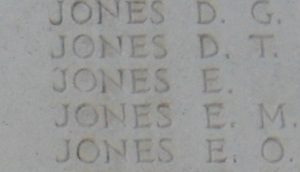
William Llewellyn Jones, Lance Corporal, 20966, South Wales Borderers. William was the son of Robert William and Gwen Jones, of Frongoch, Maentwrog. He worked in South Wales prior to the war and enlisted at Abertillery into the 10th Battalion, South Wales Borderers. The battalion was raised at Brecon by the Welsh National Executive Committee in October 1914, before moving to Colwyn Bay to join 130 Brigade, 43rd (Welsh) Division. On 29 April 1915 the formation became renumbered to 115 Brigade, 38th (Welsh) Division and moved to Winchester for the entire Division to complete its training. The entire Division moved to France from 2 December 1915 and moved to the Nursery Sector near Fleurbaix for trench initiation alongside the Guards Division. The Division then held a sector of the line near Cuinchy before marching south to the Somme sector in June 1916 to take part in the assault on Mametz Wood. The first attack on the wood was launched on a two-battalion front on 7 July, but failed, and the Divisional Commander, Sir Ivor Philipps, was replaced before the Division attacked again on a two Brigade front on 10 July 1916. After two days of ferocious hand-to-hand fighting, the wood was cleared up to its northern edge, before the battered Division was relieved. It then took over a section of the front at Hébuterne before moving to the Ypres Salient, and taking over the Canal Bank sector at Boesinghe. The infantry battalions of the Division then began carrying out the normal pattern of rotation in the trenches, four days in the front, four in support and four in reserve, whilst also working on trench improvement, digging new trenches, and also carrying out regular patrols and trench raids. On 31 July 1917 the Division launched its famous assault on the Pilckem Ridge, capturing Iron Cross and reaching its objective of the Steenbeek, then played a supporting role in the Battle of Langemarck. The Division was transferred to the Sailly-sur-la-Lys sector in September, and remained in the area over the winter before being moved to positions north of Albert, at Bouzincourt Ridge, at the end of March 1918, relieving the battered 2nd and 47th Divisions. It held this sector, again carrying out minor operations and trench raids, over the coming months, before taking part in the great offensive of 21 August 1918, and began its advance towards the Hindenburg Line. William had survived almost the entire war with the Division, but was sadly wounded just weeks away from the Armistice, probably during the Battle of the Selle. He died in hospital at Étaples on 5 November 1918, aged 25, and is buried in Étaples Military Cemetery, France.
George Mayberry Morgan, Gunner, 95069, Royal Field Artillery. George was born in Middlesex in 1895, the son of Enoch Mayberry Morgan and Bertha Morgan. His father had served in the army for several years prior to becoming a Policeman, and the family later moved to the Police Station, Maentwrog. George was residing at Pontarddulais prior to the war, and enlisted at Llanelli into the Royal Field Artillery. He was posted to France, landing on 1 June 1915, and joined B Battery, 63rd Brigade, RFA, which was attached to the 12th (Eastern) Division. George fought with the Division at Loos in September that year, and the following year fought at the Somme. In 1917 the Division fought at Arras and Cambrai, and returned to the Somme in 1918 where it again saw much fighting. On 4 September 1918 the Division relieved 18th (Eastern) Division east of the Canal du Nord and just south of Manancourt, for an attack on Nurlu, and it was here that George was killed on 5 September 1918. He was 23 years old, and is buried in Sailly-Saillisel British Cemetery, France.
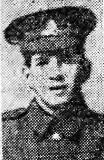
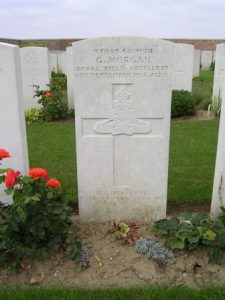
Morris Roberts, Private, 55304, Royal Welsh Fusiliers. Morris was the son of David and Jane Roberts, of Pandy Bach, Maentwrog. He enlisted at Blaenau Ffestiniog into the 7th Battalion, Royal Welsh Fusiliers, but after completing his training, was posted to France, joining the 14th Battalion, Royal Welsh Fusiliers, which was attached to 113 Brigade, 38th (Welsh) Division. Morris probably joined up with the battalion after its ordeals at Mametz Wood in July 1916 where, as did all the other battalions of the division, it had suffered heavy casualties. The battered Division then took over the line at Hébuterne before being transferred to the Ypres Salient, and took over the Canal Bank sector of the line at Boesinghe, north of Ypres. The infantry battalions of the Division then began carrying out the normal pattern of rotation in the trenches, four days in the front, four in support and four in reserve, whilst also working on trench improvement, digging new trenches, and also carrying out regular patrols and trench raids. On 5 February 1917, the 14th RWF relieved the 13th RWF in the front line, the battalion creating a number of posts, centred around 13 Lewis Gun crews situated along the battalion’s front. Apart from the battalion sending out a fighting patrol the following night, this tour was relatively quiet, but Morris was killed in action when the battalion was relieved four days later, on 9 February 1917. The 20-year-old is buried in Bard Cottage Cemetery, Belgium.
William Roberts, Private, 19196, Machine Gun Corps. William was the son of Meredith Roberts and Ellen Roberts (nee Owen), of Llwyn, Maentwrog. He worked on his grandfather’s farm prior to the war. William enlisted at Blaenau Ffestiniog into the Royal Welsh Fusiliers, and after completing his training embarked for France to join either the 1st RWF or 2nd RWF on 7 July 1915. William must have been trained as a specialist machine-gunner, and was later posted to the 217th Company, Machine Gun Corps, which arrived in La Havre, France on 17 March 1917. The Company entrained for Carnoy on 22 March, joining the 20th (Light) Division. The Division followed the German withdrawal to the Hindenburg Line over the coming weeks, advancing via Ytres to Neuville-Bourjonval towards Metz. The Division entrained for the Ypres Salient in July 1917, and went into reserve behind the 38th (Welsh) Division on the Canal Bank at Boesinghe. The 38th Division launched their assault on the Pilckem Ridge on 31 July 1917, and after a week of fighting, in terrible conditions, the 20th Division moved forwards and relieved the Welshmen. The 217th Company had been at work during the battle, digging positions in Yorkshire Trench (a section of which has been excavated and can be seen today), and fired a machine-gun barrage to aid the Welshmen after an SOS flare was sent up, due to a German counter-attack. The 20th Division relieved the 38th Division on 6 August, and carried on the attack towards Langemarck. William was slightly wounded on 3 August and evacuated to the 63rd Casualty Clearing Station, and on 18 August re-joined the Company. The Company had a brief period of rest at Proven, before moving back into positions near the front on 15 September, taking over barrage positions. William was one of two men of the Company killed in action here on 22 September 1917. William was 25-years-old and is buried in New Irish Farm Cemetery, Belgium.
David Thomas, Private, 20464, Royal Welsh Fusiliers. David was the son of Ellis and Gwen Thomas, of Hafod Fawr, Blaenau-Ffestiniog. He lived at Tai Ucha, Corwen for several years prior to the war. David enlisted at Colwyn Bay into the 14th Battalion, Royal Welsh Fusiliers. The battalion was raised at Llandudno by the Welsh National Executive Committee, joining 128 Brigade, 43rd (Welsh) Division and trained in North Wales before moving to Winchester in the summer of 1915, where the formation became renumbered 113 Brigade, 38th (Welsh) Division. The Division moved to France on 2 December 1915 and moved to the Nursery Sector near Fleurbaix for trench initiation alongside the Guards Division. The Division then held a sector of the line near Cuinchy before marching south to the Somme sector in June 1916 to take part in the assault on Mametz Wood. The first attack on the wood was launched on a two-battalion front on 7 July, but failed, and the Divisional Commander, Sir Ivor Philipps, was replaced before the Division attacked again on a two Brigade front on 10 July 1916. David was killed in action during heavy fighting that day. The 24-year-old has no known grave, and is commemorated on the Thiepval Memorial, France.
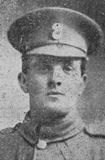
Evan Thomas, Private, 54764, Royal Welsh Fusiliers. Evan was born in Trawsfynydd in 1897, the son of Robert and Gwen Thomas. The family was residing at Tyn-y-Fedwen, Ffestiniog by 1911. Evan enlisted at Blaenau Ffestiniog into the Royal Welsh Fusiliers, and after completing his training, was posted to France, joining the 15th Battalion, Royal Welsh Fusiliers. The battalion had been raised in London, joining 113 Brigade, 38th (Welsh) Division, and had been in France since December 1915, taking part in the assault on Mametz Wood the following year. Evan would have joined the 15th RWF after its withdrawal from the Somme sector to the Canal Bank Sector at Boesinghe, north of Ypres, in August 1916. The infantry battalions of the 38th Division then began the normal routine of trench rotation, taking turns in the front line, support, then reserve, all the while carrying out improvements to the trenches, carrying out trench raids, and beating off German raids. On 17 June 1917 the 15th RWF was holding the Canal Bank line when it came under heavy fire by the German artillery, which caused 30 men killed and 60 wounded. Evan was among the men killed that day. The 20-year-old is buried in what amounts to a mass grave, in Bard Cottage Cemetery, Belgium.
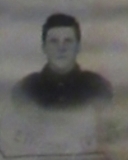
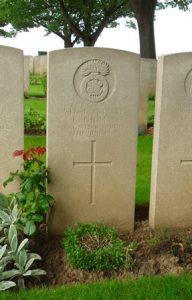
David Morris Williams, Private, 20223, Royal Welsh Fusiliers. David was the son of David and Sarah Williams, of Belle View, Tan-y-Bwlch. He worked at Brynpader Farm prior to the war. David enlisted at Blaenau Ffestiniog into the 14th Battalion, Royal Welsh Fusiliers soon after the outbreak of war. The battalion was raised at Llandudno by the Welsh National Executive Committee, joining 128 Brigade, 43rd (Welsh) Division and trained in North Wales before moving to Winchester in the summer of 1915, where the formation became renumbered 113 Brigade, 38th (Welsh) Division. The Division moved to France on 2 December 1915 and moved to the Nursery Sector near Fleurbaix for trench initiation alongside the Guards Division. The Division then held a sector of the line near Cuinchy before marching south to the Somme sector in June 1916 to take part in the assault on Mametz Wood. The first attack on the wood was launched on a two-battalion front on 7 July, but failed, and the Divisional Commander, Sir Ivor Philipps, was replaced before the Division attacked again on a two Brigade front on 10 July 1916. On 12 July the battered Division was relieved and moved to the front at Hébuterne for a month, before taking over the Canal Bank sector north of Ypres. David was seriously wounded during a trench raid there in April 1917. He was brought back to Maesteg Hospital for treatment, and upon recovering visited his parents before embarking again for France. He was then posted to the 16th Battalion, Royal Welsh Fusiliers, which was also attached to 113 Brigade, 38th (Welsh) Division. On 31 July 1917 the Division launched its assault on the Pilckem Ridge, and fought its way across the mud to its objectives of Iron Cross and the Steenbeek. David was killed in action here at some time during the day. He was 19 years old and is buried in Dragoon Camp Cemetery, Belgium.
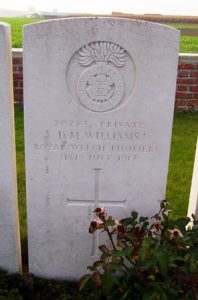
Edward John Terah Williams, Private, 67468, Cheshire Regiment. Edward was the son of John Saunders Williams and Orpah Evelyn Williams, of The Laundry, Tan-y-Bwlch. He worked as an assistant electrician prior to the war. Edward enlisted into the Royal Welsh Fusiliers at Dolgellau on 23 July 1917 and was placed on the Army Reserve for a month before being mobilised and posted to the 62nd Training Reserve Battalion at Kinmel Park. On 1 November he was posted to the 53rd (Young Soldiers) Battalion, Cheshire Regiment, and embarked for France on 3 April 1918, where he joined the 11th Battalion, Cheshire Regiment, which was attached to 75 Brigade, 25th Division. The Division had been at Favreuil when the Germans launched their Spring offensive on 21 March 1918 and the 11th Cheshire had been attached to the 6th Division, taking part in desperate fighting to attempt to stop the German offensive. The battalion then took part in a desperate rear-guard action at Morchies whilst withdrawing back towards Hébuterne over the coming days. Edward joined up with the 11th Cheshire’s at Godewaersvelde, where it had moved on 31 March to rebuild following the loss of 412 casualties. Unfortunately, this sector was hit by the second phase of the German Spring offensive on 9 April, and the battered 25th Division was thrown into the fight again, being in the line north of Ploegsteert Wood when the Germans attacked. The 11th Cheshire came under attack the following day, and was forced to withdraw, along with the rest of the line, suffering heavy casualties over the coming days. Edward was reported as being wounded and missing during the fighting of 20 April 1918. No trace of the 18-year-old was ever found, so he was presumed to have been killed on that date. He has no known grave and is commemorated on the Tyne Cot Memorial, Belgium.
Ellis Williams, Private, 291240, Royal Welsh Fusiliers. Ellis was the son of Richard and Ann Williams, of Penyglannan, Maentwrog. He enlisted at Blaenau Ffestiniog into the 7th Battalion, Royal Welsh Fusiliers on 19 November 1915, and was posted to the 3/7th Battalion, Royal Welsh Fusiliers at Park Hall, Oswestry for training. On 3 July 1916 Ellis embarked at Devonport for Egypt, and joined the Base Depot at Alexandria ten days later. On 19 July Ellis was posted to the 1/7th Battalion, Royal Welsh Fusiliers. The battalion was attached to 158 Brigade, 53rd (Welsh) Division, and been in Egypt since December 1915, when the Division was evacuated from Gallipoli. The Division then joined the EEF, and helped guard the Suez Canal before taking part in operations to drive the Turks out of the Sinai. The EEF then turned its attention onto driving the Turks out of Palestine, and on 26 March 1917 launched its first offensive against the coastal city of Gaza, which guarded the road to Jerusalem. Initial gains during the day were lost when the assaulting divisions lost touch with each other and communication broke down when a thick fog cloaked the battlefield. Ellis was posted as missing believed killed in action during the days fighting. The 26-year-old has no known grave and is commemorated on the Jerusalem Memorial, Israel.
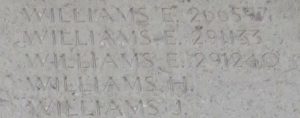
World War Two, 1939-1945
Alfred Albert Clements, Sergeant, 1801772, Royal Air Force Volunteer Reserve. Alfred was the son of Alfred Clements and Alice Clements (nee Jopson), of Essex. He married Lizzie Jordan Roberts, of Maentwrog, in 1944. Alfred enlisted into the Royal Air Force Volunteer Reserve. He trained as a Wireless Operator before being posted to 500 Squadron, RAF, which was a Coastal Command unit. Initially equipped with Avro Anson’s, the squadron helped cover the evacuation of the BEF from Dunkirk in 1940. It then re-equipped with Bristol Blenheim’s and were utilised on anti-shipping and air-sea rescue duties, as well as night intruder operations over German-occupied Europe. The squadron then converted to Lockheed Hudsons, and flew anti-submarine patrols from bases in Scotland and Northern Ireland, then moved to RAF St Eval before being moved to Gibraltar, to cover Operation Torch, and flew anti-submarine operations over the Mediterranean. From December 1943 the squadron re-equipped with Lockheed Venturas, and operated from a number of bases in Sicily and Italy, before disbanding on 11 July 1944. It was then reformed as a Bomber Command Squadron on 1 August 1944 at La Sénia, and was equipped with the Martin Baltimore light bomber. On 26 January 1945, Alfred was flying aboard Martin Baltimore V, Serial FW794, on a propaganda leaflet dropping operation to Argenta. The Baltimore came down and crashed into a farmhouse near Occhiobello, just north of Ferrara, killing all four crewmen. Alfred was 23 years old when he was killed during the crash. The four men were identified by their serial numbers on their flying jackets and were buried in the civil cemetery at Occhiobello. The four men’s graves were exhumed and re-buried in Padua War Cemetery, Italy on 25 April 1946.
Evelyn Eileen Williams, Leading Wren, 1160, Women’s Royal Naval Service. Evelyn was born in Penrhyndeudraeth on 3 July 1921, the daughter of Watkin Dresser Williams and Doris Evelyn Williams (nee Morgan). Her father had served in WW1, before joining the Police and had been a Police Sergeant at Tywyn prior to the war. Evelyn enlisted into the Women’s Royal Naval Service, and was attached to HMS Monck, the Combined Forces training establishment at Largs. She was attached to the landing carrier training centre at Port Glasgow. Evelyn took ill whilst based there and died of Bronchiectasis at Hairmyres Hospital, near Glasgow on 21 January 1945, aged 23. Her remains were brought home for burial in St. Twrog Churchyard, Maentwrog.